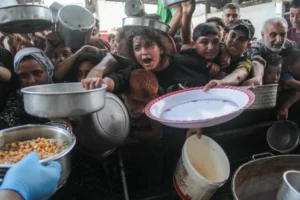Weaponizing starvation, Israel seeks full control over Gaza aid distribution

Palestinians line up to receive food cooked by a charity kitchen in northern Gaza, 11 September 2024
Lee Mordechai and Liat Kozma write in +972 on 26 March 2025:
For almost a month, not a single drop of humanitarian aid has entered Gaza. Since March 2 — when the second phase of the ceasefire was due to commence, only for Israel to renege on its commitment to the deal — Israel has blocked the entry of all food into the Strip, along with fuel, medical equipment, and other essential supplies. The UN Relief and Works Agency (UNRWA) has warned that Gaza’s flour stores will likely run out completely before the end of this week.
While the current policy is more extreme than anything we’ve seen since October 7, Israel has nonetheless imposed restrictions on the entry of aid into Gaza throughout its onslaught. Already in December 2023, Human Rights Watch declared that Israel was using starvation as a weapon of war. Almost a year later, the International Criminal Court issued arrest warrants for Israeli Prime Minister Benjamin Netanyahu and then-Defense Minister Yoav Gallant, in part on the grounds that they had “intentionally and knowingly deprived the civilian population in Gaza of objects indispensable to their survival, including food.”
The surge of humanitarian aid that Israel allowed to enter Gaza during the recent two-month ceasefire only served to underscore the cruel intentionality of the starvation policy. Israel argued for months — including in a year-long case at the High Court of Justice, in response to a petition by five Israeli human rights organizations — that any obstacles to the entry of aid were not its fault, attributing them instead to the inefficiencies of humanitarian agencies or looting by gangs. Yet the data paint a clear picture to the contrary.
While the quality and quantity of available data about the volume and composition of aid entering Gaza have declined significantly since the beginning of the ceasefire in mid-January (the two primary sources of information, the Israeli army’s Coordinator of Government Activities in the Territories, or COGAT, and the UN Office for the Coordination of Humanitarian Affairs, or OCHA, have stopped providing detailed dashboard updates), we can still see that the number of aid trucks authorized to enter Gaza increased dramatically, helping to somewhat alleviate the humanitarian crisis in the Strip.
